This deep, rich, Turkish Coffee Recipe, is also known as Greek Coffee and Arab Coffee. The espresso used to make this Turkish coffee recipe is blended with ground cardamon, which gives this coffee its wonderful flavor. Serve with freshly made Middle Eastern baklawa or Turkish delight and a tall glass of water!
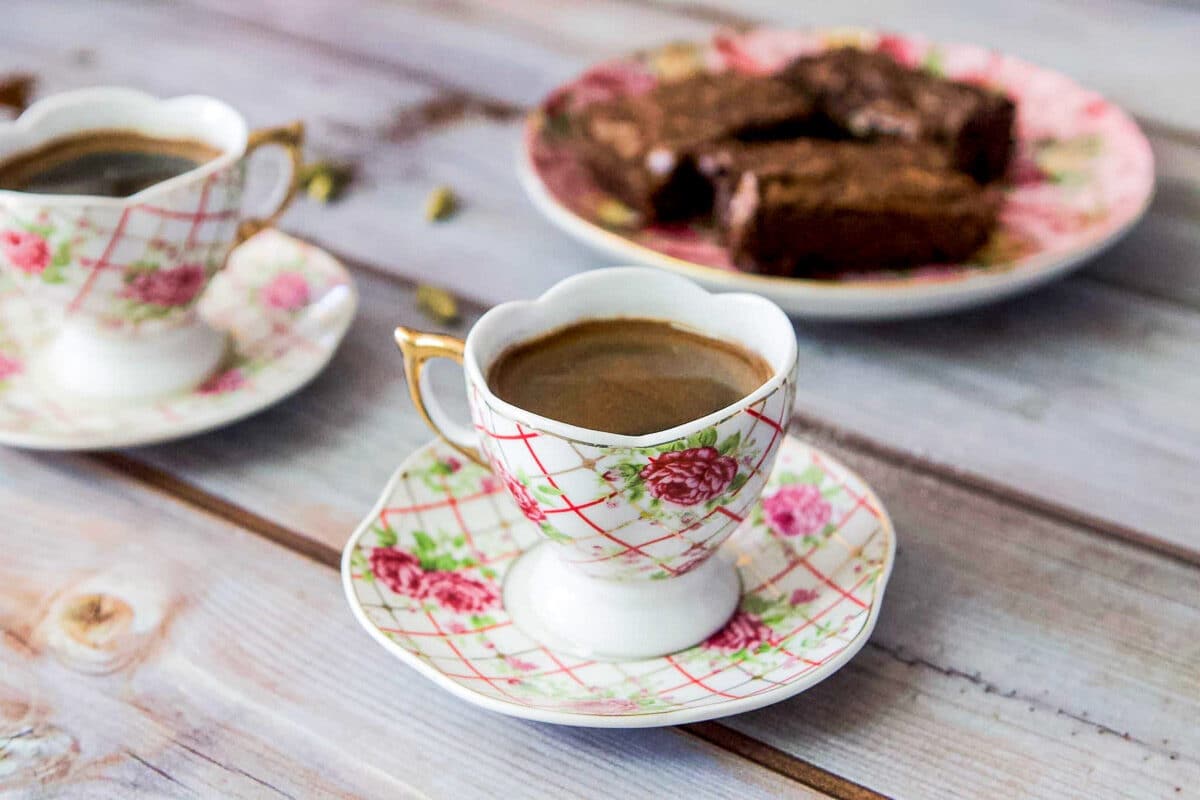
Growing up, this coffee was always referred to as Gahwha in our home. Gahwha is the Arabic word for Turkish Coffee. It is also widely known as Arab Coffee throughout the Middle East. It is prepared in a Turkish Coffee Maker known as an Ibrik.
I'll never forget the time I served my Greek friend, Jenny, a cup of Turkish coffee. I made the mistake of calling it just that. Jenny quickly corrected: "You mean, Greek coffee!" Given the history between Greeks and Turks, I'm sure you understand why...So choose your words wisely, depending on who you will be serving!
Jump to:
- 🛒 What You Need For This Recipe
- 🔖 Ingredients & Substitutions
- ☕️ How to Make Turkish coffee
- 🤷🏻♀️ Recipe FAQs
- 👩🏼🍳 Pro Tips
- 😍 Why You'll Love This Recipe
- 🛒 What Goes into this recipe
- 🔖 Ingredient & Substitutions
- 🍬 How to make Turkish delight
- 🤷🏻♀️ Recipe FAQs
- 👩🏼🍳 Pro Tips
- 🍳 More Turkish Recipes
- 🫖 More Coffee Recipes
- 📖 Recipe
- 💬 Comments
🛒 What You Need For This Recipe
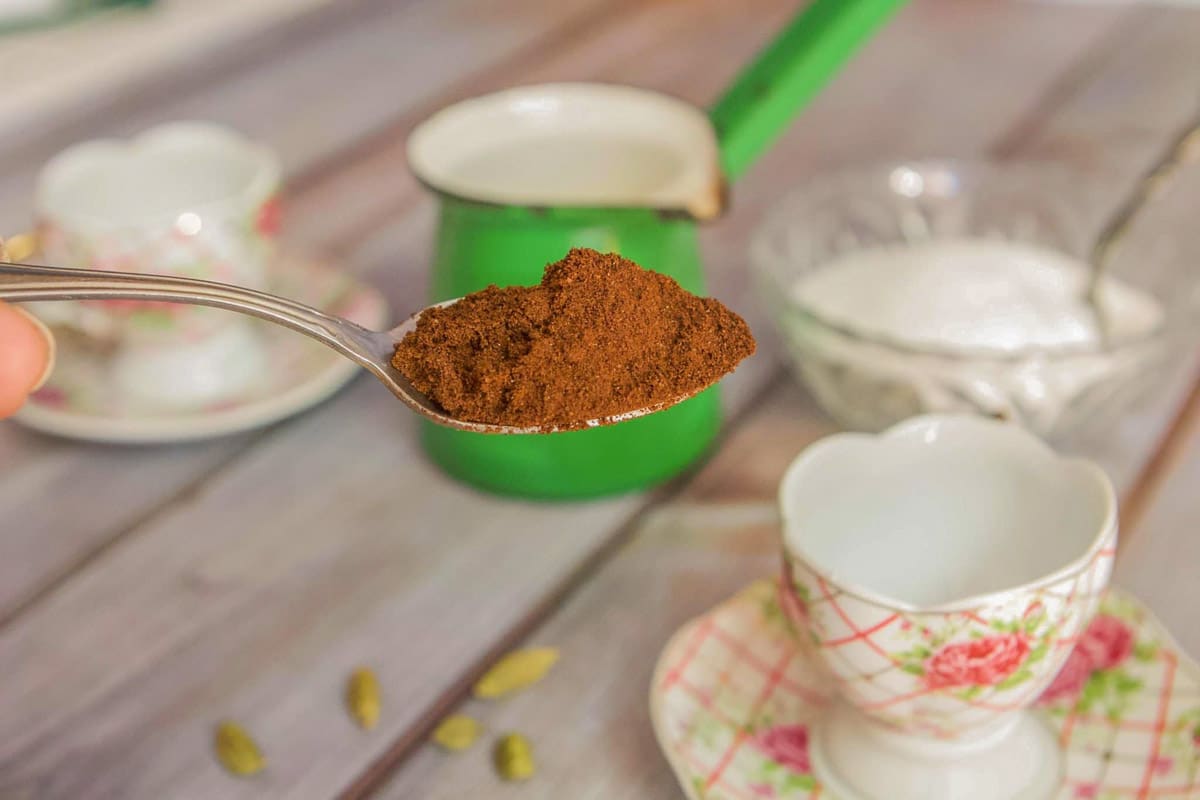
🔖 Ingredients & Substitutions
- Turkish Coffee Grounds - Finely ground Arab Coffee Beans.
- Cardamom - Cardamom powder or pods are ground in with the coffee beans, giving this coffee its unique flavor.
- Sugar or Sweetener - Turkish coffee is usually prepared with sugar but you can also use the sweetener of your choice, or leave it out completely.
- Water or Milk - Although traditionally water is mixed in with the coffee grounds, there are some who make it with milk instead.
☕️ How to Make Turkish coffee
Step 1: Mix coffee, water, and sugar in an ibrik or Turkish coffee pot.
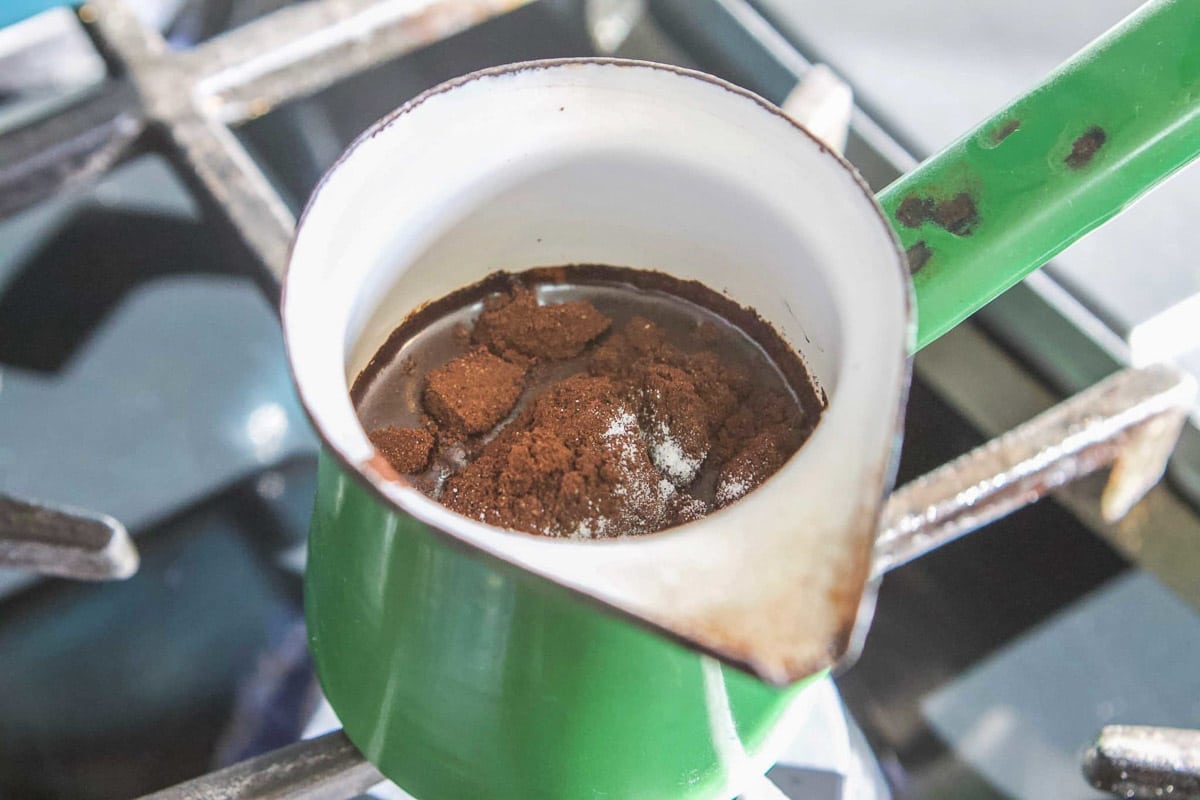
Step 2: Stir over medium flame, occasionally lifting the Turkish coffee pot off of the flame to keep your hand from burning, as you stir.
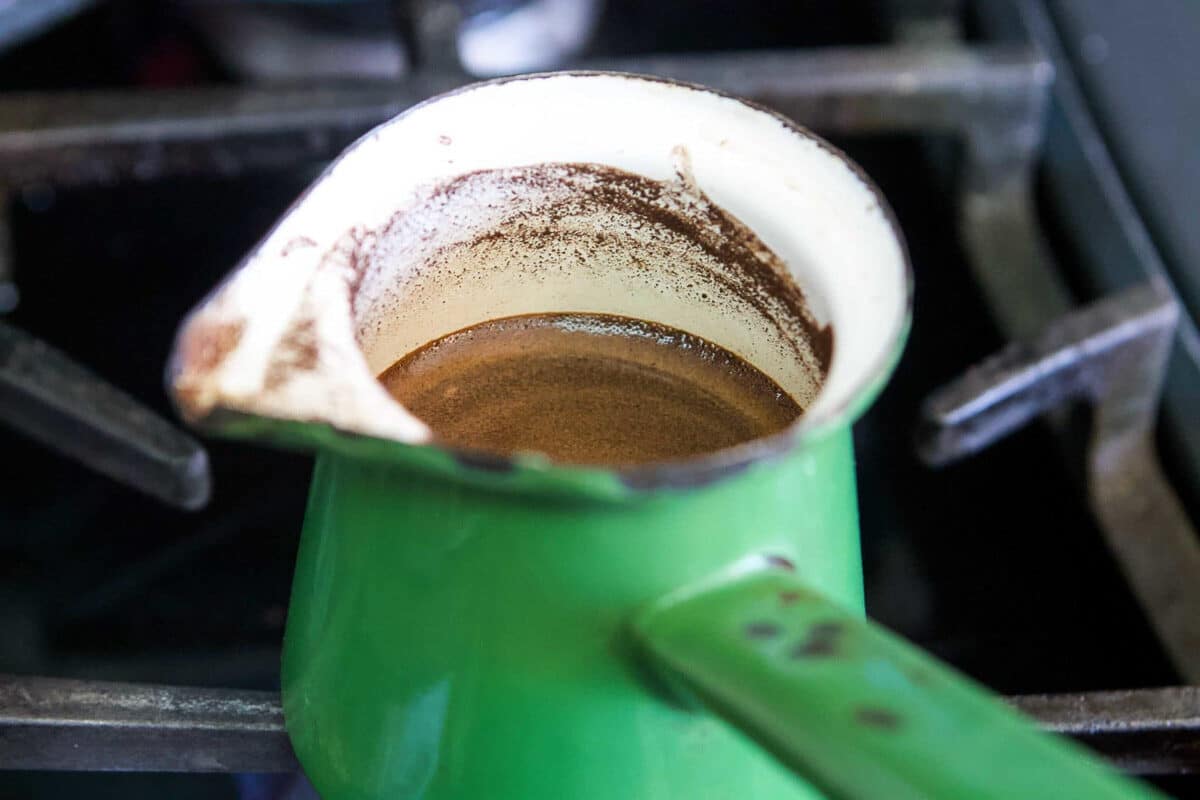
Step 3: When the coffee begins to rise to the surface remove the Turkish coffee pot from heat and allow the coffee to recede. Repeat this step a few times. This is an important step and develops a richer flavor, so don't skip it!
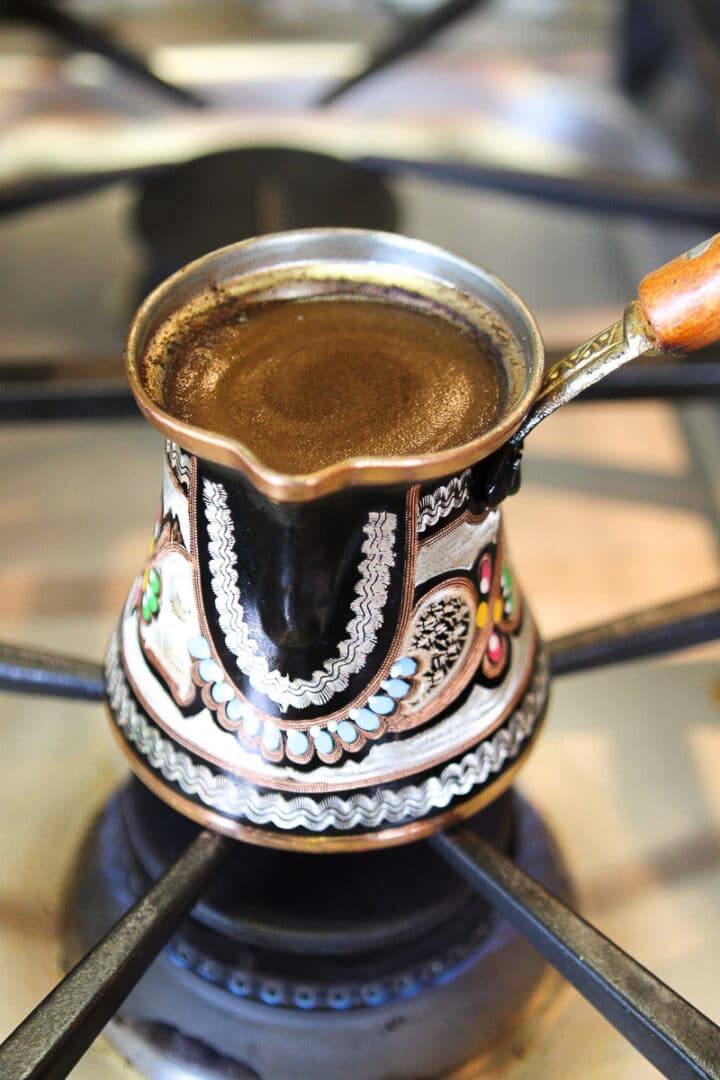
Step 4: Spoon some of the foam into each demitasse cup. Divide the remaining coffee between the two cups.
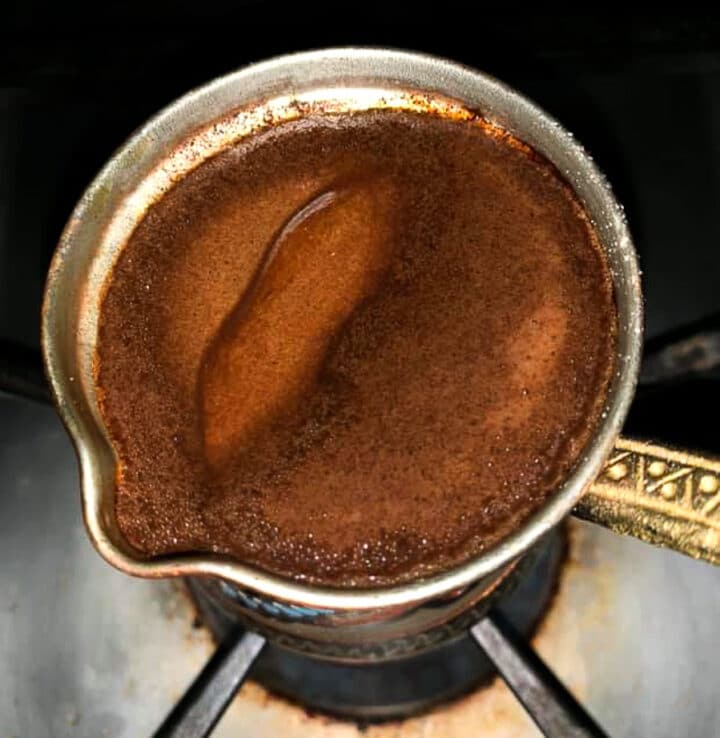
Step 5: Allow the coffee to rest for a minute or two. This will help the sediment to settle to the bottom of the cup. Enjoy you Arab Coffee!
🤷🏻♀️ Recipe FAQs
To make this Turkish Coffee Recipe, you'll need a few ingredients. To start, you'll need the obvious, Turkish/Arabic coffee.
Make sure that the coffee you buy has cardamom ground in; cardamom is the main reason that I'm in love with this coffee!
Aside from coffee, you'll need sugar, or a sweetener, such as Truvia. You will also need an "Ibrik" which is the coffee pot used to make this coffee.
Lastly, you'll need the demitasse cups in which the coffee is served.
You may use espresso cups if you choose to. However, if you don't have the majority of the above-mentioned ingredients or supplies, I would highly recommend this Turkish Coffee Kit which has everything you need!
Turkish coffee is served in special Turkish coffee cups, as mentioned above. The coffee is usually served with a tall glass of ice water, along with something sweet on the side.
This could be anything from baklava, a piece of chocolate, or Turkish Delight. Yes, Turkish delight is actually a thing. They're not an imaginary candy that the witch tempted Edmond with, in the movie The Lion, the Witch, and the Wardrobe.
Turkish Delight is very hard to prepare, so I recommend purchasing it from Amazon.
These days there are many ways to make this coffee. One option that will cost you around $30 is an electric Turkish Coffee maker. This gadget allows you to make Turkish Coffee without burning your hand, as it is plugged in instead of requiring you to stir the coffee over a flame.
A cheaper option is to use a small saucepan. A pot that is narrow and taller is preferred, especially if it has a pouring spout.
A more expensive option (Beko 2 cup Turkish Coffee Maker) can be purchased for around $130. This coffee maker allows you to make up to two cups of coffee at a time using your favorite Turkish coffee blend.
Of course, you can always use Turkish coffee K-Cups. What? You didn't know there was such a thing? I'm here to tell you that not only do they exist, but they're amazing! Keep reading to learn more.
👩🏼🍳 Pro Tips
- To make this Turkish Coffee recipe will need one heaping teaspoon of Turkish coffee, one demitasse cup of water (or ⅓ of a cup), and ½ to 1 tsp. of sugar per cup.
- I make a minimum of two cups at a time, even if I'm the only one having some. To accomplish this, I use 2 demitasse cups of water, 2 heaping spoons of coffee, and 1 teaspoon of sugar (or a packet of Truvia).
- To make more servings, just increase the coffee and water by one part, and the sugar by ½ to 1 part. You might even want less sugar than that, it's a matter of personal preference.
- You will need to lift the ibrik off the flame occasionally to keep your hand from burning, as you stir. Stop stirring when bubbles start forming along the edges of the ibrik, and the foam starts rising to the surface.
- We call the foam that rises to the surface "pata" which means "face" in Assyrian. This foam is highly desirable. Your goal should be to divide the foam between all the servings.
How to Tell Fortune with Turkish Coffee
Middle Eastern countries have been telling fortunes with coffee grounds for centuries. When a person finishes drinking their coffee, there is sediment that collects on the bottom.
The cup is covered with the saucer, and swiftly flipped over and set aside for ten minutes or so. During this time, the sediment begins to create a pattern on the walls of the cup as it drains into the saucer.
The cup is then flipped, and "read." Imagination is used to interpret not only what is seen, but what it signifies. This custom varies from those doing it "just for fun" and those who claim to be able to predict the future.
The ones who take this practice seriously divide the cup into sections, each representing a different aspect of your life. One section representing the past, another the future, and different topics including love life, prosperity, and so on...

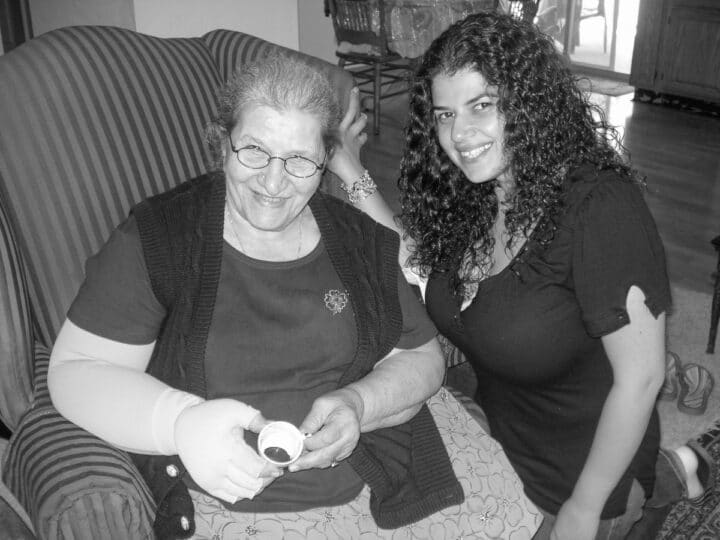
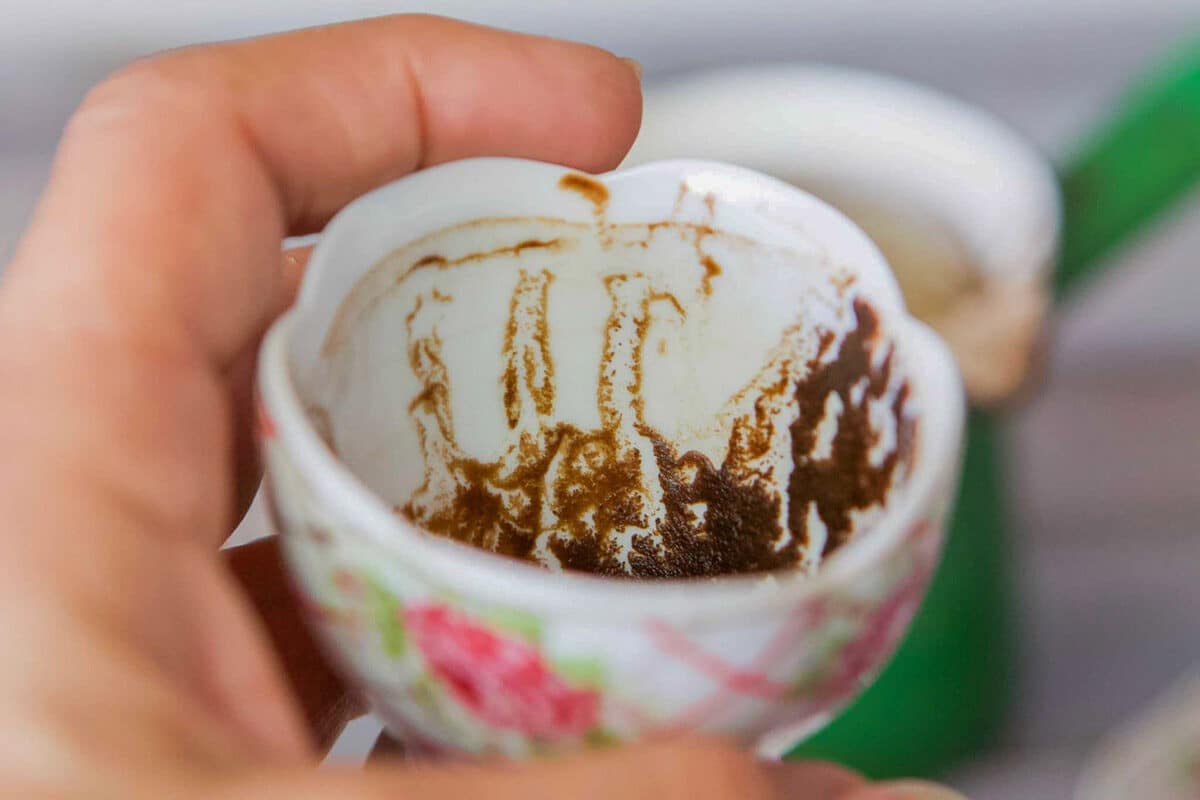

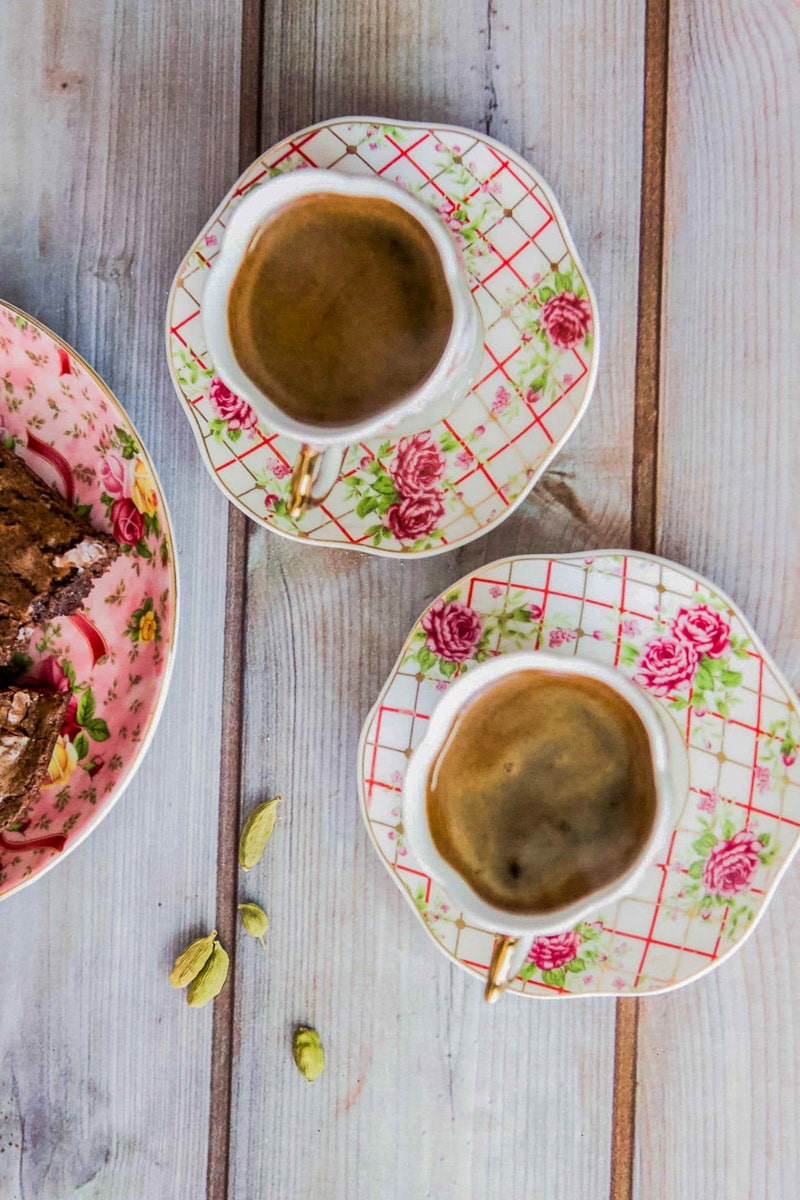
You Are Here Home » Recipes » Middle Eastern Recipes
Published: Dec 3, 2020 Updated: Dec 29, 2023 by Hilda Sterner | This post may contain affiliate links Leave a Comment
(edit post info)
Easy Turkish Delight Narnia Candy | Lokum
Sharing is caring!
206shares
Turkish Delight, or Lokum, is a sweet, gummy candy that originated in Turkey and is popular throughout the Middle East. You can easily prepare this Turkish Delight Narnia Candy at home with my simple recipe! To enjoy it the traditional way, serve it with a hot cup of Turkish coffee.
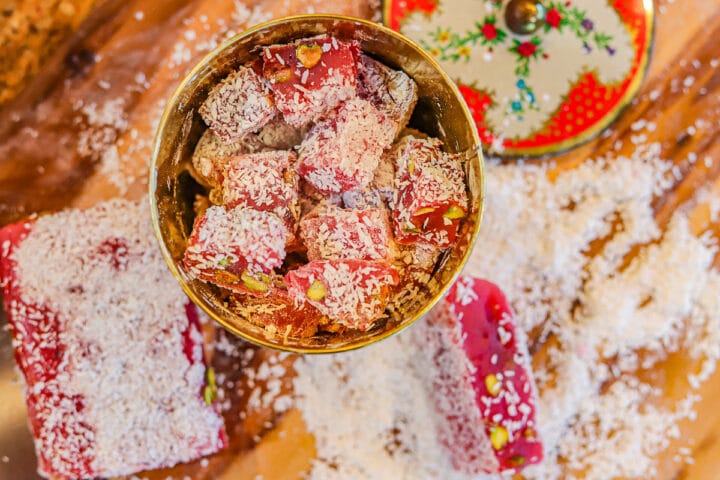
If you're familiar with C.S. Lewis' The Chronicles of Narnia, (The Lion, the Witch, and the Wardrobe, more specifically), then you might be familiar with this magical candy. In this story, the white witch gets Edmund to betray his siblings with this irresistible candy.
0 seconds of 15 secondsVolume 0%
How fun would it be to watch this classic with your kids and surprise them with some Turkish Delight Narnia Candy? By the way, if you can find it, I recommend the cartoon version of the movie, it's my favorite!
In Turkey, you can find Lokum displayed in store windows, where it is available in a variety of flavors including strawberry, orange, raspberry, pomegranate, and lemon.
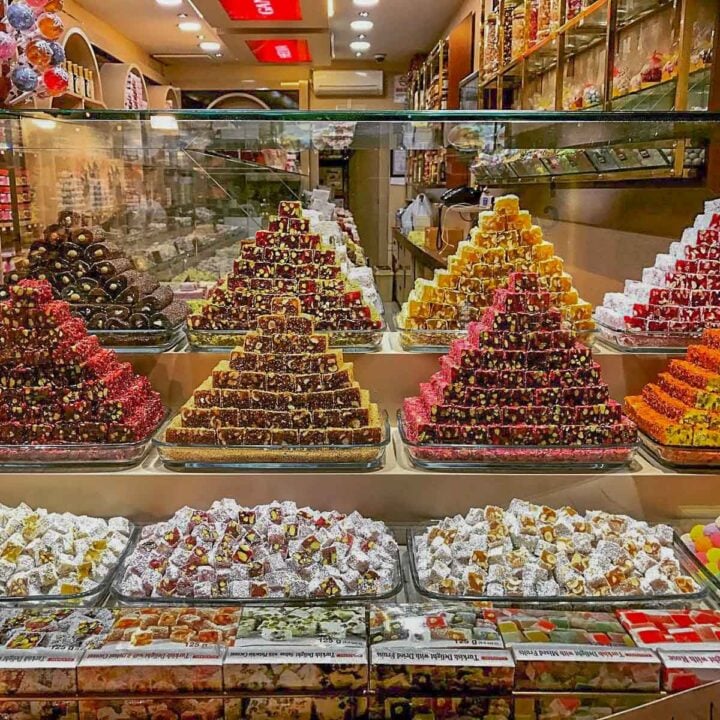
Jump to:
- 😍 Why You'll Love This Recipe
- 🛒 What Goes into this recipe
- 🔖 Ingredient & Substitutions
- 🍬 How to make Turkish delight
- 🤷🏻♀️ Recipe FAQs
- 👩🏼🍳 Pro Tips
- 🍳 More Turkish Recipes
- 🥮 Related Recipes
- 📖 Recipe
- 💬 Comments
Would you like to save this recipe?
😍 Why You'll Love This Recipe
If you've tried to make Turkish delight candy in the past and were disappointed, you're in good company. Many complicated recipes call for using a candy thermometer while you boil the syrup until the syrup reaches the softball stage. The mixture is then mixed in with the cornstarch.
Over the years I've experimented with many Turkish delight recipes which were unsuccessful. Recently, however, someone shared a Turkish delight recipe that called for gelatin, which I hadn't tried adding to my previous recipes.
I decided to try making Turkish delight with the added gelatin and tossed in some cream of tartar for good measure. This seemed to do the trick. This Turkish delight recipe is pretty close to the real thing and easy to follow, so you should have success with it too!
🛒 What Goes into this recipe
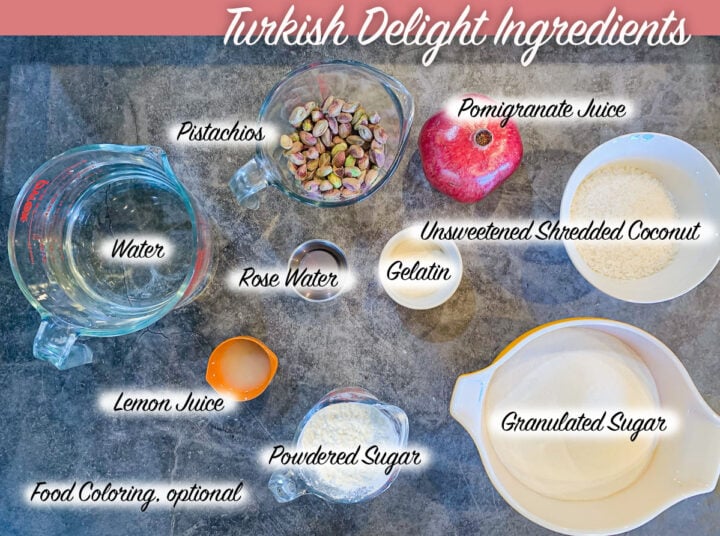
🔖 Ingredient & Substitutions
- Rose Water: Traditional Turkish Delight is flavored with rose water. Although we're using pomegranate juice for this recipe, I still like to sneak in some rose water to get that classic Lokum taste.
- Coconut: Sometimes Turkish Delight is rolled in a mixture of cornstarch and icing sugar, while other types are rolled in coconut. Unsweetened shredded coconut works best.
- Gelatin: Three packets (or 2 tablespoons) of unflavored gelatin are used in this recipe.
- Nuts: My recipe calls for pistachios, however, you can substitute hazelnuts, almonds, or walnuts.
🍬 How to make Turkish delight
Step 1: Prepare an 8" x 8" pan by lining it with parchment paper. Use enough paper to go up to the sides of the pan. Sprinkle some coconut on the parchment paper and set aside until needed.
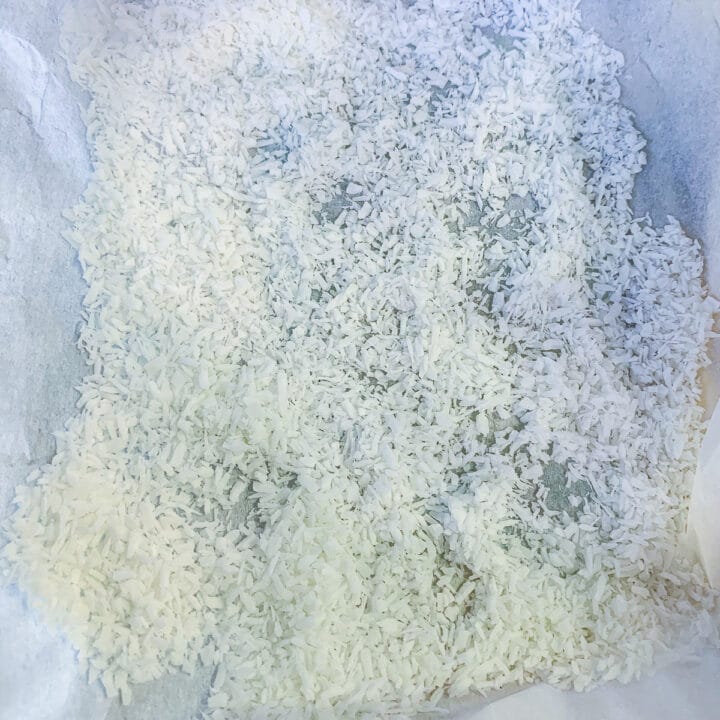
Step 2: Measure and place your ingredients within easy reach. Add sugar, cornstarch, gelatin, and cream of tartar in a medium-sized saucepan. Whisk the cornstarch mixture to combine.
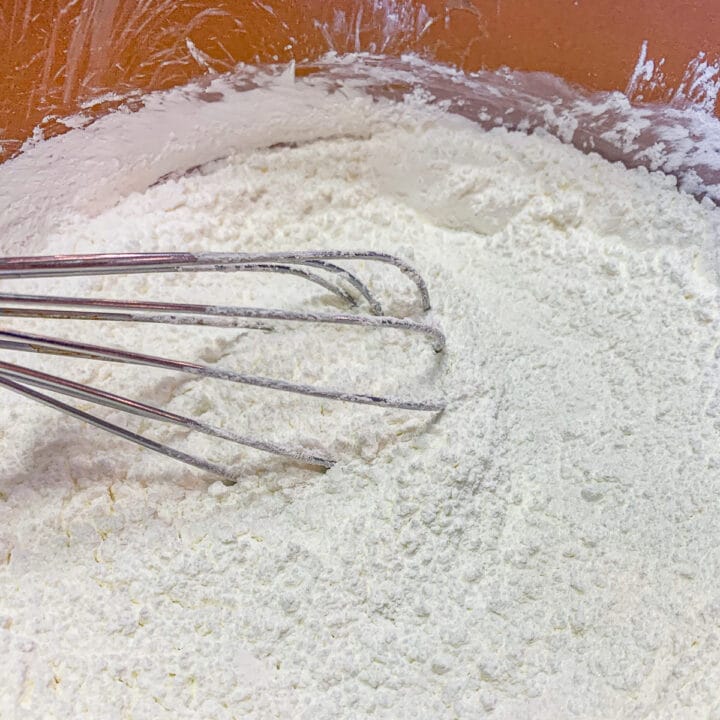
Step 3: Mix cold water and lemon juice in a large cup or bowl. Pour the liquid over the contents of the saucepan. Whisk quickly, to prevent lumps. Continue until smooth.
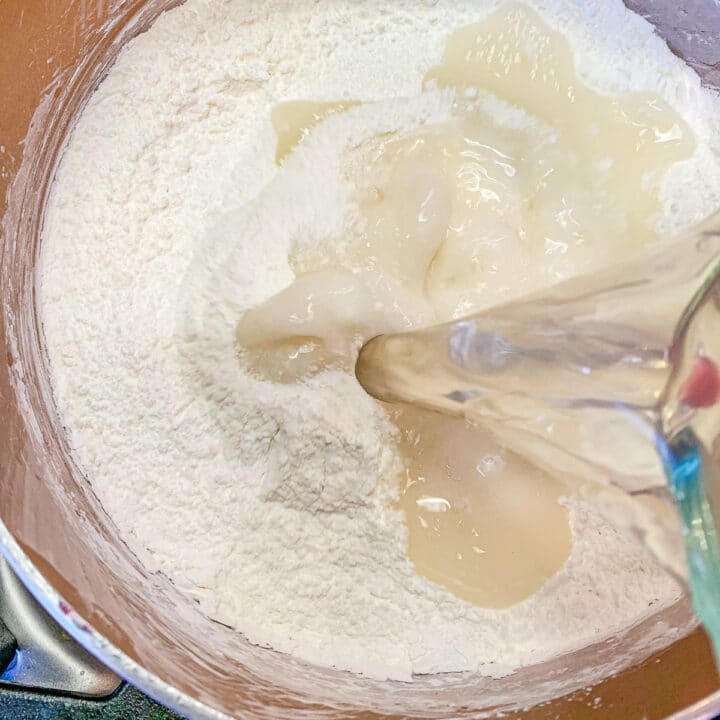
Step 4: Whisk, over low heat, until very thick. This should take approximately 30 minutes. Meanwhile, heat a pan on another burner and toast the shelled pistachios over low heat for a few minutes.
Would you like to save this recipe?
We'll email this post to you, so you can come back to it later!
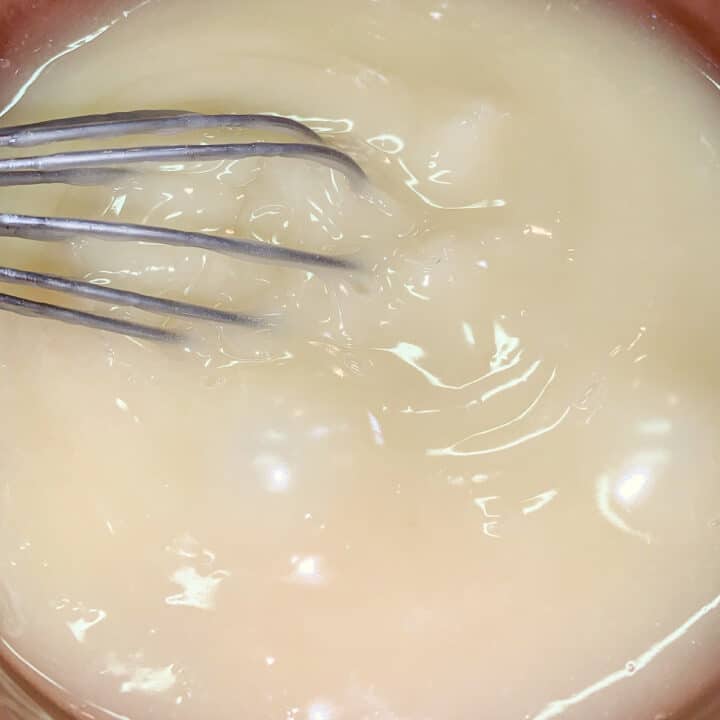
Step 5: After approximately 20 minutes of cooking, whisk the pomegranate juice and rose water into the pot. (If you prefer a deeper color add some red food coloring). If the mixture is too thick, you can use a spoon or a spatula to mix it. Stir continuously to prevent the bottom of the mixture from sticking to the pot.

Step 6: The Turkish delight will start to bubble and eventually pull away from the bottom and edges of the pan. When this happens, stir nuts into the mixture and turn out into the prepared pan.
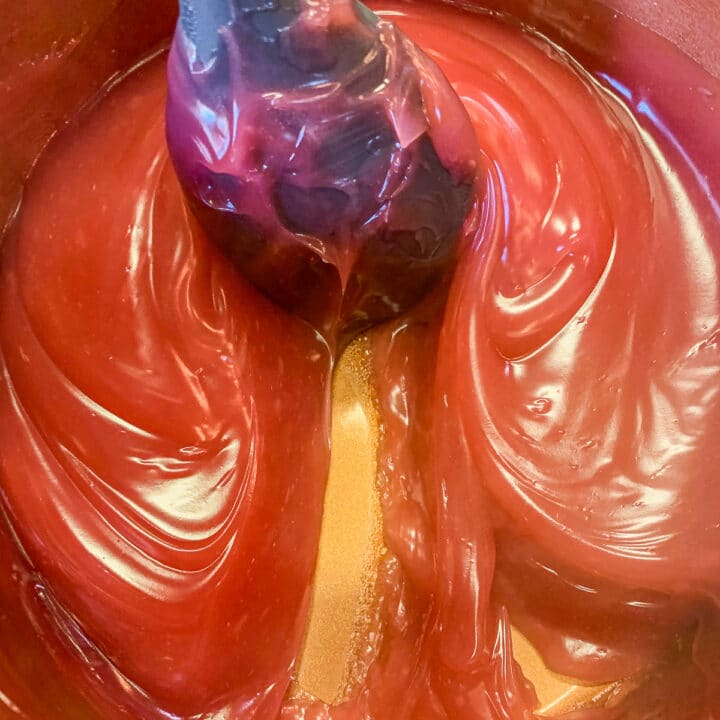
Step 7: Smooth the top of the Turkish delight with a spatula and sprinkle with coconut. Allow to set on the counter for approximately 8 hours or overnight.
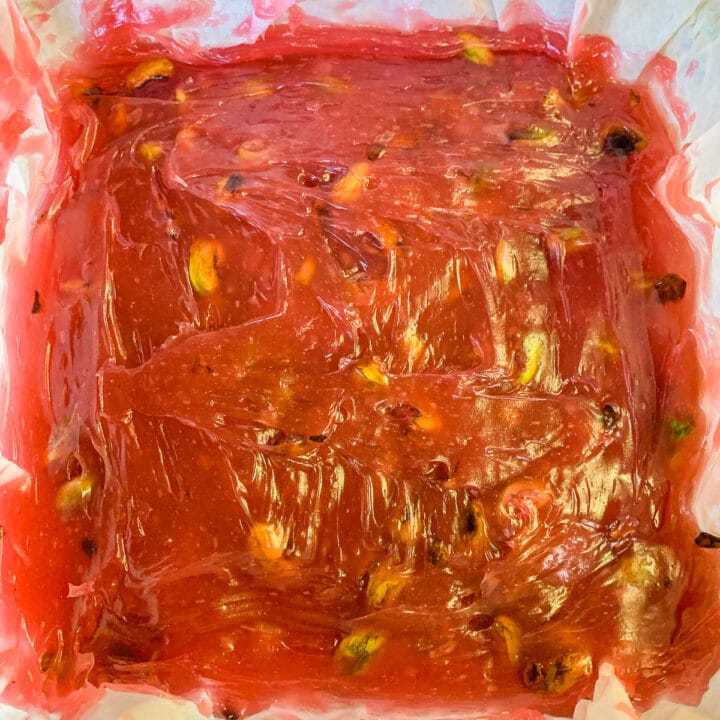
Step 8: Remove the Turkish delight from the pan by lifting the parchment paper out of the pan and flipping it onto a cutting board. Dust the cutting board with coconut and slice the Turkish delight into small cubes using a sharp knife or a bench scraper.
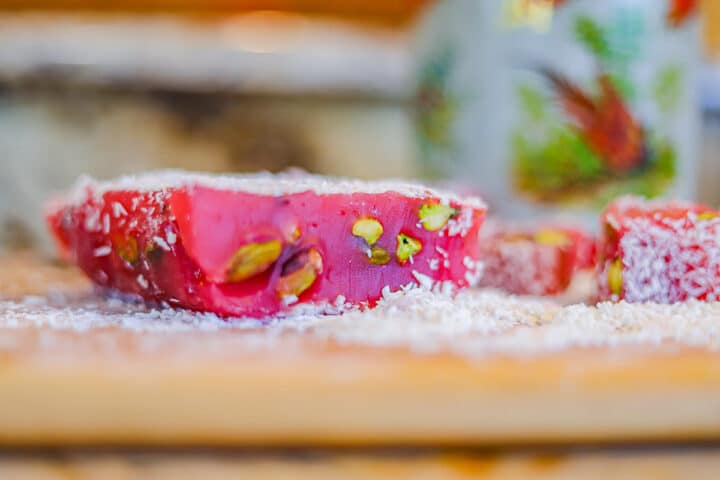
Step 9: Toss cubed Turkish delight with the remaining coconut to keep the pieces from sticking together. Store in an airtight container or wrap individually in plastic wrap.

🤷🏻♀️ Recipe FAQs
What does Turkish Delight taste like?
How should you store Turkish Delight?
Is Turkish delight a Christmas thing?
What is Turkish Delight supposed to taste like?
👩🏼🍳 Pro Tips
- Sometimes Mastic Gum, or (Gum Arabic) is used in Lokum recipes, which is a resin from the mastic tree. Mastic Gum comes in small chunks and as a powder and is used as a food stabilizer and a thickening agent in fillings, soft candy, and chewing gum. If purchasing the powder form of Gum Arabic, make sure the label reads "food safe" as some brands are used in crafting and may have other ingredients added.
- If you prefer a firmer texture, allow the cubed Turkish delight to sit out on the counter, uncovered overnight.
- Most often, Lokum is tossed in a mixture of cornstarch and confectioner's sugar, however, I prefer using coconut.
- Store in an airtight container in the fridge.

🍳 More Turkish Recipes
If you want to make an entire Turkish meal, here are some dishes to get you started!
🫖 More Coffee Recipes
If you enjoyed this Turkish coffee recipe, check out these other related coffee posts!
Did you make this recipe?
📖 Recipe
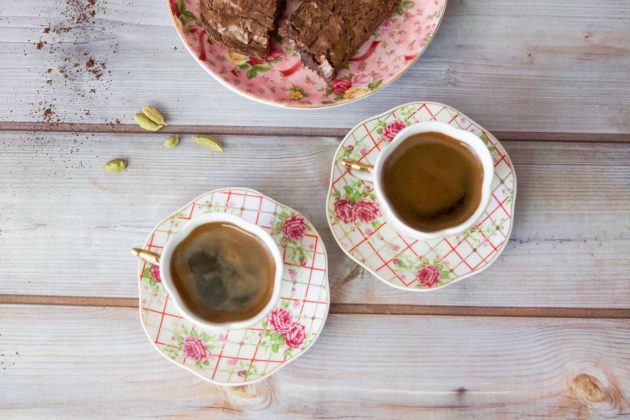
Turkish Coffee Recipe
Ingredients
Equipment
Method
- Mix coffee, water, and sugar in an ibrik or Turkish coffee maker.
- Stir over medium flame, occasionally lifting the ibrik off of the flame to keep your hand from burning, as you stir.
- When the coffee begins to rise to the surface remove from heat and allow to recede. Repeat this step a few times. This develops a richer flavor.
- Spoon some of the foam into each demitasse cup. Divide the remaining coffee between the two cups.
- Allow the coffee to rest for a few minutes. This will help the sediment to settle to the bottom of the cup. Enjoy!
Nutrition
Notes
- You will need one heaping teaspoon of Turkish coffee, one demitasse cup of water (or ⅓ of a cup), and ½ to 1 tsp. of sugar per cup.
- I make a minimum of two cups at a time, even if I'm the only one having some. To accomplish this, I use 2 demitasse cups of water, 2 heaping spoons of coffee, and 1 teaspoon of sugar (or a packet of Truvia).
- To make more servings, just increase the coffee and water by one part, and the sugar by ½ to 1 part. You might even want less sugar than that, it's a matter of personal preference.
- You will need to lift the ibrik off the flame occasionally to keep your hand from burning, as you stir. Stop stirring when bubbles start forming along the edges of the ibrik, and the foam starts rising to the surface.
- We call the foam that rises to the surface "pata" which means "face" in Assyrian. This foam is highly desirable. Your goal should be to divide the foam between all the servings.


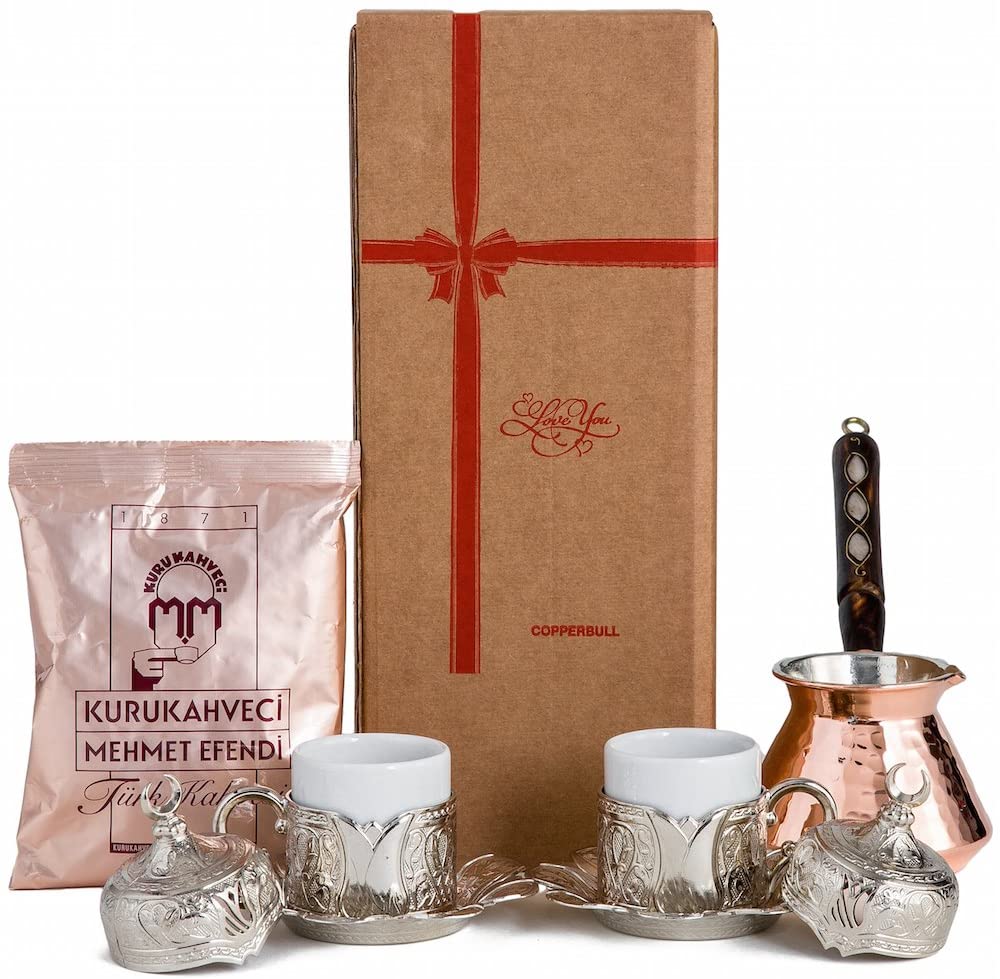
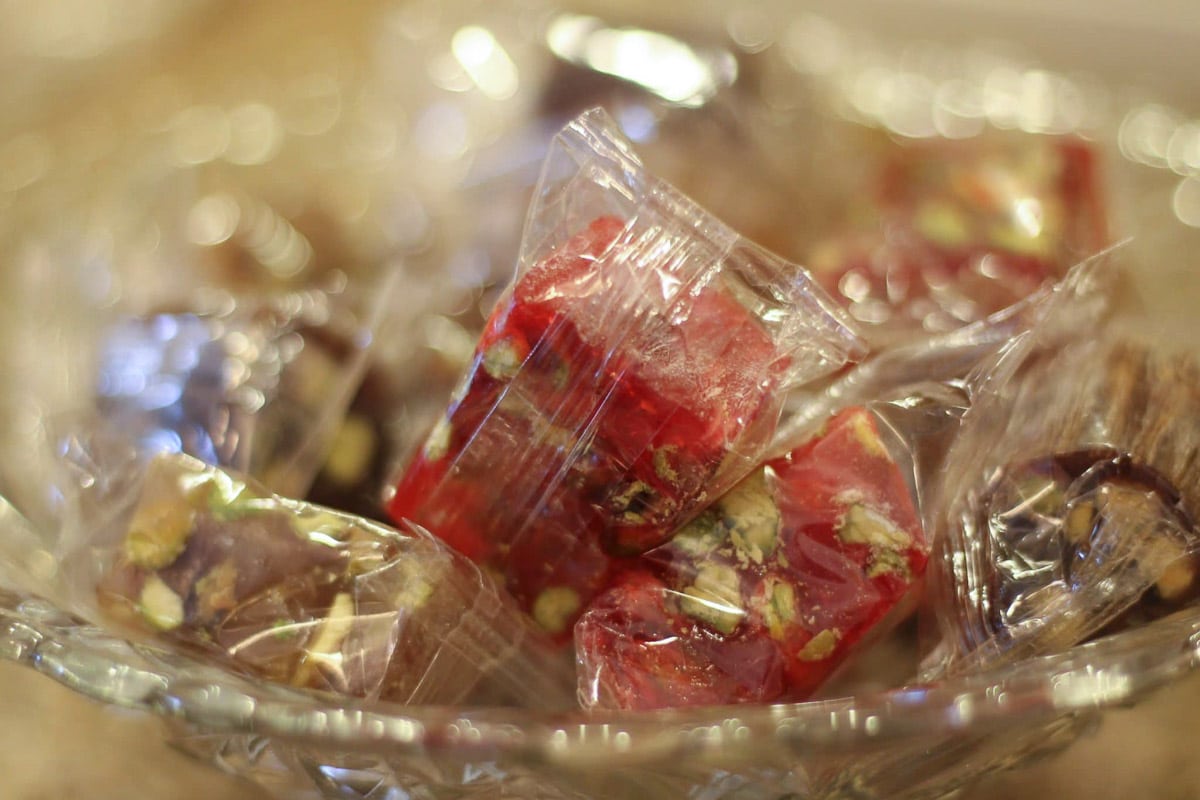




Comments
No Comments